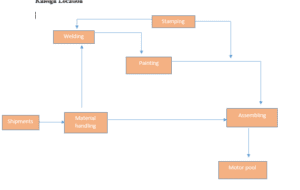Product Design and Analysis and Process Flow Charts
Product design analysis
| Plant | Product | Product design analysis | |
| Strategy A | Strategy B | ||
| Raleigh location | Frames | Emphasize occupant safety.
Use advanced engineering techniques. Reducing noise, vibration, and harshness. |
Emphasize structural rigidity.
Use artificial intelligence (3D printing). Reduce wear and tear by using high-quality material. |
| Montgomery location | Enclosures | Bonnet design emphasizes reducing air resistance
Emphasize pedestrian safety |
Bonnet design emphasizes reducing dust accumulation
Emphasize car occupants’ safety |
| Nashville location | Axel and wheel assemblies | Assemble-to-order
Assembly simulation and testing |
Make-to-order
Batch process assembly |
The success of the manufacturing processes requires creating an effective operation strategy. According to Schroeder & Goldstein (2024), operational strategy is a consistent pattern of operations’ decisions and the associated supply chain that is connected to the business strategy and other functional strategies resulting in a competitive advantage. The main strategies that will be used to design the frames will be emphasizing occupant safety, using advanced engineering techniques, and reducing noise, vibration, and harshness. The alternative strategies that will be used to design the frames will be emphasizing structural rigidity, using artificial intelligence such as 3D printing, and reducing wear and tear by using high-quality material. The manufacturers will begin by implementing the main strategies before considering the alternative strategies because the alternative strategies focus on addressing the weaknesses of the main strategies.
The main strategies that will be used to design the enclosures are emphasizing reducing air resistance when designing the bonnet and emphasizing pedestrian safety. The alternative strategies will include emphasizing reducing dust reduction when designing the bonnet and emphasizing car occupant safety. Alternative strategies will be considered when improving the strength and durability of the enclosure. The design process for axle and wheel assemblies will also include main and alternative strategies. The main manufacturing strategies that will be used in the axle and wheel assembly product design will be assembly-to-order and assembly simulation and testing. The alternative strategies will be make-to-order and batch-process assembly. Assemble-to-order includes assembling components based on macroeconomic trends, market conditions, and historical information. Assembly simulation and testing include conducting process optimization and assembly trials to support the product development cycle. Make-to-order includes beginning the production process after the client confirms the order. Make-to-order will be considered to reduce waste and customize the axel and wheel based on customer needs.
Process flow charts
Raleigh Location
The flow chart above indicates that the manufacturing of frames at Raleigh will begin with welding and then proceed to painting, assembly, and motor pool. Welding will include other processes, such as stamping and material handling. The shipments in the manufacturing process will be moved to material handling before being moved to assembly and then to the motor pool. Assembling will also be linked to stamping and painting.
Montgomery Location
Manufacturing at Montgomery will involve development, product preparation, and production. Development will include planning, designing, prototyping, and evaluation. Product preparation will involve equipment tryouts, equipment verification, process planning, productivity examination, equipment procurement, and quality checks. Production will involve stamping, welding, painting, assembly, and inspection.
Nashville Location
Manufacturing at the Nashville location will include assembling tuber and linchpin, testing and assembling ball bearing, assembling sensor, assembling brake disk and hub, assembling brake and dish and linchpin, assembling and packing left caliper, assembling and packing right caliper, assembling shock absorber, final product storage, washing hub and brake disk, raw material storage and creating a spring assembly line.
References
Schroeder, R., & Goldstein, S. (2024). Operations management in the supply chain: Decisions & cases. McGraw-Hill Education.
ORDER A PLAGIARISM-FREE PAPER HERE
We’ll write everything from scratch
Question
You are the VP of Operations at JTL Enterprises, a medium-sized organization (750 employees), that manufactures cargo and utility trailers. The company’s corporate office is located in Atlanta, Georgia but has plants throughout the Southeast in Montgomery, Alabama, Nashville, Tennessee, and Raleigh, North Carolina. The frames are manufactured in the Raleigh location. The enclosures are manufactured in the Montgomery location. The axel and wheel assemblies are manufactured in the Nashville location. The Atlanta plant is responsible for assembling all of the sections and shipping them to customers.

Product Design and Analysis and Process Flow Charts
The Final Project will be due at the end of the course, which will consist of an operations plan for a specific company. The project will be divided into three sections. Each phase will provide specific criteria that you will use in the application of the concepts found in the text and through discussion and assignments. This DOES NOT have to be all essay. Be creative and innovative. Use tables, graphs, etc. for the compilation of information. Think critically about each phase.
Below is a synopsis of the three phases:
Phase 1: Product Design and Process-Flow Analysis
Phase 2: Quality Control Mechanisms
Phase 3: Inventory Control, Materials Planning, and Supply-Chain Management
The Final Project will include all three phases into ONE document.
This week, you will complete Phase 1 of the project
1. From the information in the text, create a product design analysis for each plant that is specific to its part of the process. You will need to think strategically, so you will want to review Table 2.3 (page 28) for ideas. Be aware that the strategic alternatives may be different for each plant since each one is tasked with different parts of the overall product.
2. Complete a process-flow chart for each plant. Pay close attention to the process type needed for each plant. (See table 4.2).




